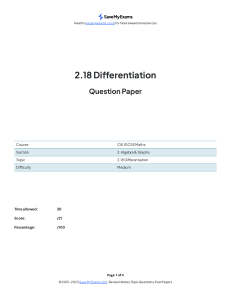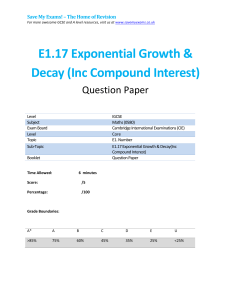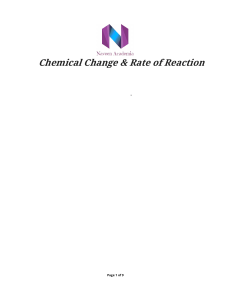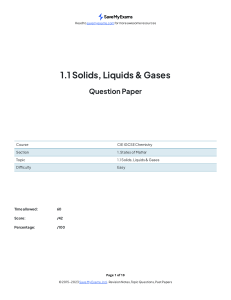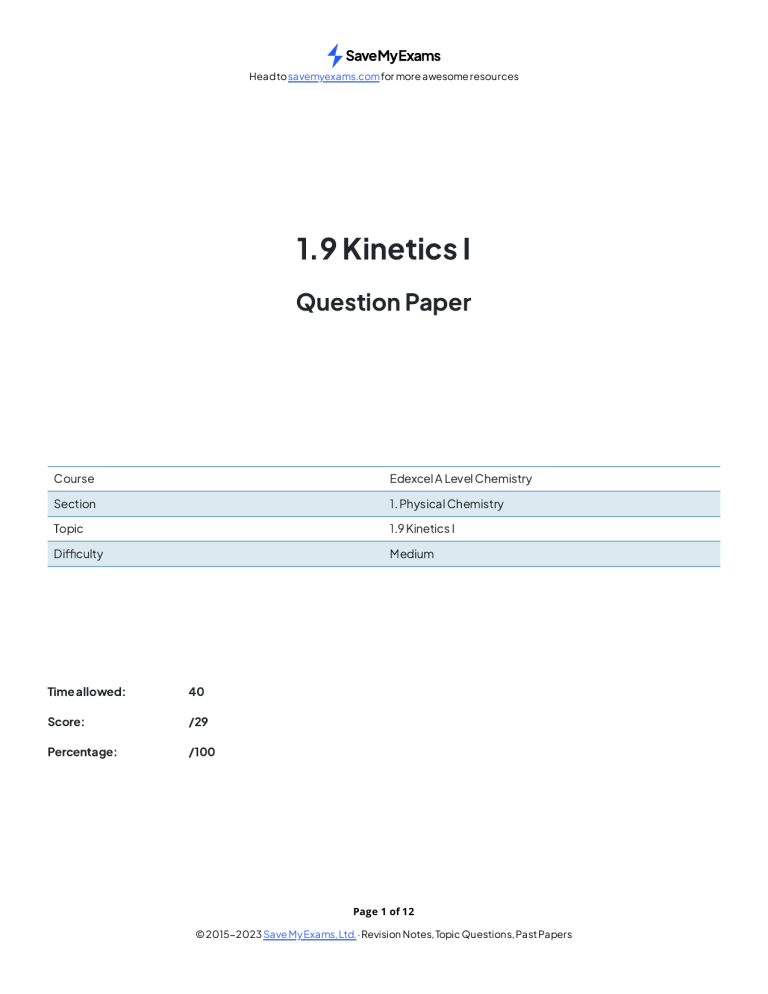
Head to savemyexams.com for more awesome resources 1.9 Kinetics I Question Paper Course Edexcel A Level Chemistry Section 1. Physical Chemistry Topic 1.9 Kinetics I Difficulty Medium Time allowed: 40 Score: /29 Percentage: /100 Page 1 of 12 © 2015-2023 Save My Exams, Ltd. · Revision Notes, Topic Questions, Past Papers Head to savemyexams.com for more awesome resources Question 1a This question is about reaction kinetics. The best way to describe the activation energy of a reaction is ☐ ☐ ☐ ☐ A B C D the average energy of the particles when they react the difference in energy between the reactants and the products the minimum energy required to make the particles collide the minimum energy required for a reaction to occur [1 mark] Page 2 of 12 © 2015-2023 Save My Exams, Ltd. · Revision Notes, Topic Questions, Past Papers Head to savemyexams.com for more awesome resources Question 1b The diagrams show two reaction profiles for the same reversible reaction involving gaseous reactants. Shown on each diagram are the reaction profiles for the pathway without a catalyst and the pathway catalysed by a heterogeneous catalyst. i) In which diagram does the arrow represent the activation energy for the backward reaction when a catalyst is present? (1) ii) Estimate, using the diagram, the decrease in the activation energy for the forward reaction when a catalyst is added. Page 3 of 12 © 2015-2023 Save My Exams, Ltd. · Revision Notes, Topic Questions, Past Papers (1) Head to savemyexams.com for more awesome resources ☐ ☐ ☐ ☐ A B C D 75 kJ mol−1 100 kJ mol−1 175 kJ mol−1 200 kJ mol−1 [2 marks] Question 1c State why a solid (heterogeneous) catalyst is suitable for a reaction in the gas phase. [1 mark] Page 4 of 12 © 2015-2023 Save My Exams, Ltd. · Revision Notes, Topic Questions, Past Papers Head to savemyexams.com for more awesome resources Question 1d The diagram shows a Maxwell‐Boltzmann distribution of molecular energies for gaseous molecules. i) Which is the area of the graph corresponding to the number of molecules with sufficient energy to react when a catalyst is present? ☐ ☐ ☐ ☐ A B C D Y Y-Z Y+Z Z ii) Which would always result in a decrease in the number of molecules contained within area Y? ☐ ☐ ☐ ☐ A B C D decreasing the temperature of the gas increasing the pressure of the gas putting the gas in a smaller container removing a quarter of the catalyst (1) (1) [2 marks] Page 5 of 12 © 2015-2023 Save My Exams, Ltd. · Revision Notes, Topic Questions, Past Papers Head to savemyexams.com for more awesome resources Question 2a A series of experiments was carried out to investigate the factors which affect the rate of reaction between calcium carbonate and dilute hydrochloric acid. CaCO3(s) + 2HCl(aq) → CaCl2(aq) + H2O(l) + CO2(g) 50.0 cm3 of hydrochloric acid was added to 10 g of calcium carbonate (an excess) in a conical flask placed on an electronic balance. The loss in mass of the flask and its contents was recorded every 30 seconds for 10 minutes. The experiment was repeated using different sized pieces of calcium carbonate, a different concentration of hydrochloric acid or a different temperature. Experiment Size of calcium carbonate 1 2 3 4 small pieces small pieces one large piece small pieces Concentration of hydrochloric acid / mol dm−3 0.50 0.50 0.50 1.00 The results of Experiment 1 are shown on the graph. Page 6 of 12 © 2015-2023 Save My Exams, Ltd. · Revision Notes, Topic Questions, Past Papers Temperature /°C 20 60 20 20 Head to savemyexams.com for more awesome resources Draw curves on the graph to show the results you would expect for Experiments 2, 3 and 4. Label the curves 2, 3 and 4. [3 marks] Question 2b Determine the initial rate of reaction for Experiment 1. You must show your working on the graph. Include units in your answer. Initial rate of reaction ......................................................... Page 7 of 12 © 2015-2023 Save My Exams, Ltd. · Revision Notes, Topic Questions, Past Papers Head to savemyexams.com for more awesome resources [3 marks] Question 2c A student was required to devise an alternative method of carrying out this experiment that involved collecting the gas produced. Outline the procedure that the student could use, including a diagram and the measurements needed. [4 marks] Page 8 of 12 © 2015-2023 Save My Exams, Ltd. · Revision Notes, Topic Questions, Past Papers Head to savemyexams.com for more awesome resources Question 3a Aqueous hydrogen peroxide decomposes according to the following equation. 2H2O2 (aq) → 2H2O (l) + O2 (g) The decomposition is catalysed by manganese(IV) oxide. This can be investigated by measuring the volume of oxygen produced at various times as the reaction proceeds. Part of the apparatus used in the experiment is shown. The manganese(IV) oxide is placed in a small glass container, which is then tipped over to start the reaction. A stop clock is started at the same time. Complete the diagram to show how the gas can be collected and its volume measured, labelling the apparatus used. [2 marks] Page 9 of 12 © 2015-2023 Save My Exams, Ltd. · Revision Notes, Topic Questions, Past Papers Head to savemyexams.com for more awesome resources Question 3b An experiment was carried out using 0.25 g of manganese(IV) oxide granules and 50 cm3 of aqueous hydrogen peroxide of concentration 0.16 mol dm−3. The results are shown in the table and plotted on a graph. Time/s Volume of O2 / cm3 0.0 0 20.0 51 30.0 68 50.0 85 60.0 88 80.0 91 100 92 120 92 150 92 i) The rate of reaction may be assumed to be approximately constant up to the first volume measurement (20.0 s in this experiment). Use this approximation to calculate the initial rate of this reaction, giving the units with your answer. ii) Draw a tangent at 40 s on the graph and use it to calculate the rate of reaction at this time. iii) Page 10 of 12 © 2015-2023 Save My Exams, Ltd. · Revision Notes, Topic Questions, Past Papers (1) (2) Head to savemyexams.com for more awesome resources The experiment was repeated on a different day when the laboratory was 20 °C warmer. The volume of oxygen was recorded for the same total time of 150 s. Draw the line that you would expect to obtain in this experiment. Assume the pressure in the laboratory is the same. No calculation is required. iv) Explain, using collision theory, any differences between the line you have drawn and the original line of best fit. (2) (2) [7 marks] Page 11 of 12 © 2015-2023 Save My Exams, Ltd. · Revision Notes, Topic Questions, Past Papers Head to savemyexams.com for more awesome resources Question 3c Catalysts are not used up during a reaction. Manganese(IV) oxide acts as a heterogeneous catalyst. Describe in outline a method to show that the manganese(IV) oxide is not used up in the decomposition of hydrogen peroxide and that it still functions as a catalyst. [4 marks] Page 12 of 12 © 2015-2023 Save My Exams, Ltd. · Revision Notes, Topic Questions, Past Papers
